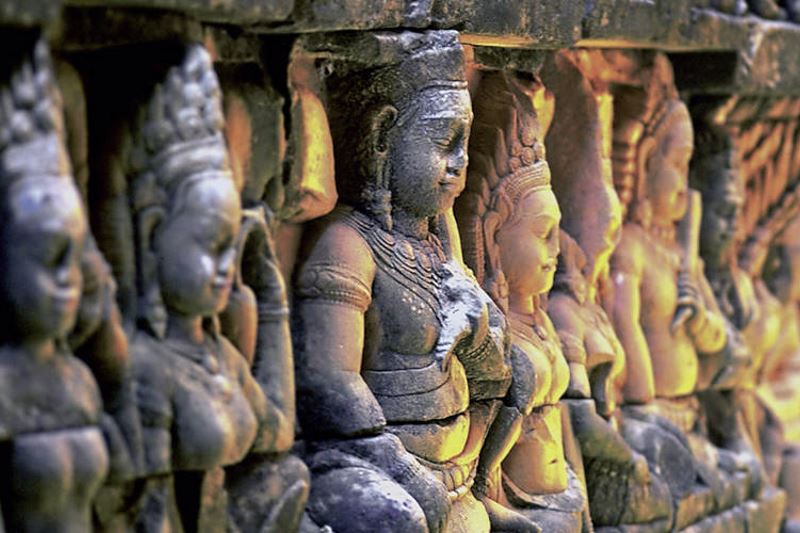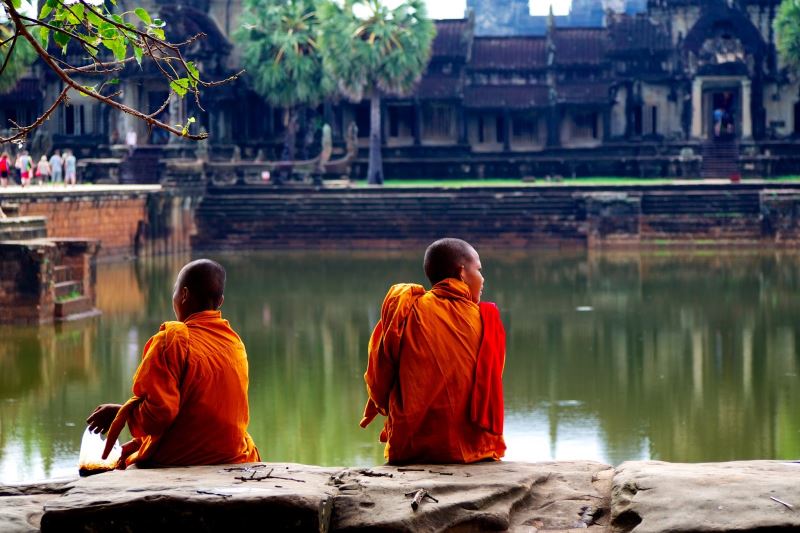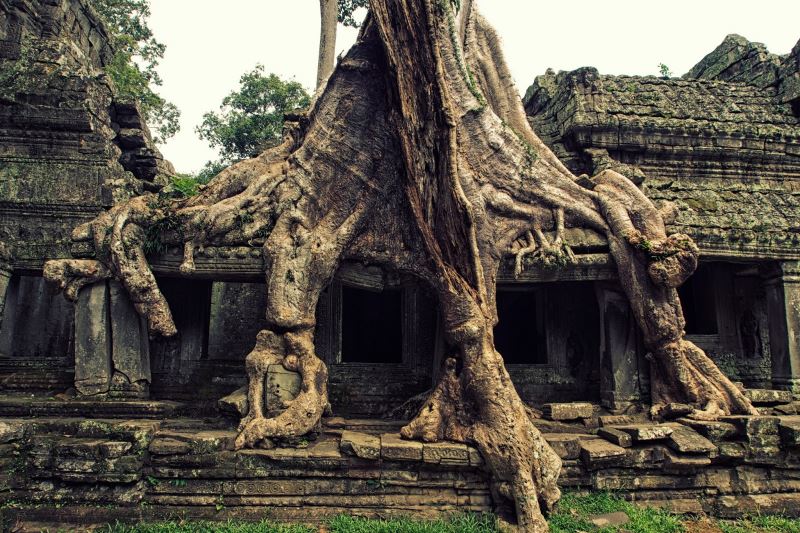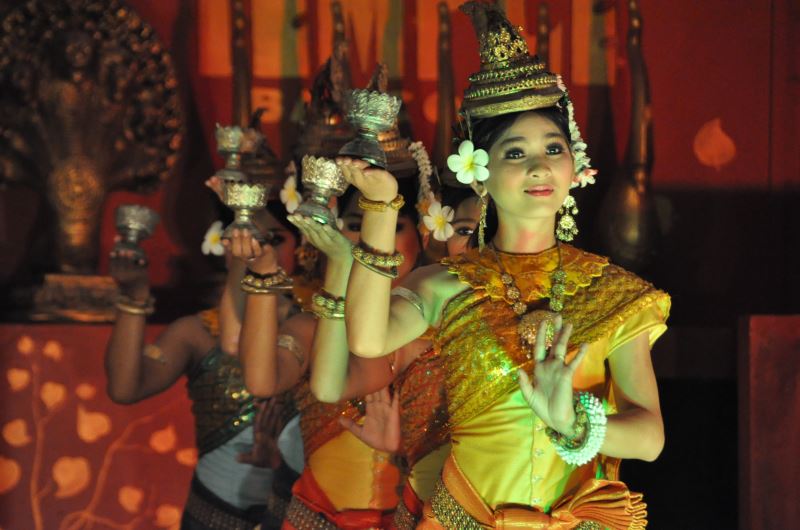
Believe it or not, Siem Reap isn’t the second biggest city after Phnom Penh - it’s Battambang! Though a popular destination for travelers, Battambang manages to avoid an overly touristy vibe, and remains a perfect place to experience a more local side of life in Cambodia.
There are quite a few ancient temples nearby to explore while in Battambang such as Wat Banan (also known as the mini-Angkor Wat) and Phnom Sampeu, which is a former killing cave network for the Khmer Rouge, now home to a moving memorial monument, or you can try the risky bamboo railway since French era! If you are lucky enough to be there on a Thursday, Phare Ponleu Selpak is a performance school that trains young locals in the performing arts, and puts on weekly performances which are spectacular. Sunset is the best time to visit The Bat Cave, where you can see hundreds of fruit bats flying out in an impressive stream for almost an hour.
‘Kep–sur-Mer’ came to prominence with the French of the early 20th century, before becoming a popular weekend retreat for the Khmer elite in the 50’s. Tragically the town suffered more than much of Cambodia during the 1970’s, witnessing some of the most ferocious fighting between Khmer Rouge and the forces loyal to the government. The city lay all but deserted for the following few decades before intuitive expats began to rebuild and remodel the town into the Kep you see today.
The town does not boast the fine beaches of Sihanoukville, however it is exactly this that makes the place so special. There's not a tacky seaside shop to be found, the local wood shack restaurants serve some of the finest seafood in Asia and the hotels have been created or restored by innovative expats with an eye for some unique Khmer-Colonial flare!
Rabbit Island is just a short boat ride away and makes for a great day trip or even overnight stay on the beach. In addition, the nearby province of Kampot is home to a large National Park and Bokor Mountain, both of which can easily be reached on a day trip. There region is well suited for cycling and there are several Angkor-era ‘cave-temples’ to be explored.
The south-western corner of Cambodia is a nature lover's paradise. To reach the region, you have to drive south-west from Phnom Penh, and then up along the Koh Kong Conservation Corridor. This area is rich in nature and bio-diversity, thankfully protected by the Cambodian government. The Cardamom Mountains are home to gibbons and monkeys, amongst other primates, and a wide variety of birdlife, such as hornbills. You may even spot an elephant if you are very lucky. The stunning range makes an impressive backdrop to much of the drive, and can be reached by a small detour from the main road south.
The remote village of Chi Pat, only accessible by dusty track, has joined forces with several neighboring settlements to form a community-based eco-tourism project. Founded by the Wildlife Alliance, the project consists of a few basic guesthouses and home stays. The villagers are also participating in administration, cooking and guiding. Activities on offer range from relaxed cycling to overnight camping in the hills and full-on five day treks. Mountain biking and boating are both available, and your program will be arranged to suit your preferences.
Travelling further south, across the Tatai Bridge and through the small town of Koh Kong, there are a number of interesting spots to explore, the most popular probably being the Peam Krasaop Mangrove Forest and the town itself.
Mondulkiri, officially Mondul Kiri, is a province of Cambodia. Bordering the provinces of Kratié to the west, Stung Treng to the northwest, Ratanakiri to the north and the country of Vietnam to the east and south, it is the most sparsely populated province in the country despite being the largest in land area.
The capital of Cambodia, situated on the lazy banks of the Mekong River, was once known as the ‘Pearl of Asia’ and is still famous for its beautiful colonial architecture. If Siem Reap is the city to learn about Cambodia’s ancient history, Phnom Penh is undoubtedly the place to learn about the modern. It was only 1979 when the Vietnamese army liberated the city from the Khmer Rouge, and the city still bears some of the grit from the past. With tragedy in its past, Cambodia is still coming to terms with its future, and Phnom Penh represents the economic and diplomatic growth of the country as a whole.
Two of the most popular sites for tourists are the Tuol Sleng Genocide Museum, also known as S-21, and the Killing Fields of Choeung Ek. Tuol Sleng was a high school that had been converted into a prison during the Khmer Rouge’s occupation of Phnom Penh when the majority of the city’s population had been exiled to the countryside, and Killing Fields was where S-21’s prisoners were later killed and buried in mass graves. If you have more than a day in Phnom Penh, you can take a city tour to see the Silver Pagoda and Royal Palace, the astonishing collection of skilled Khmer sculpture and art at the National Museum, Wat Phnom (where Phnom Penh gets its name) and the buzzing Russian Market.
Preah Vihear is quite a big northern province of Cambodia. Its capital is called Phnom Tbeng Meanchey. The province itself is named after the temple of Prasat Preah Vihear, what is definitely the hotspot of this province. Much of the province is extremely remote and strongly forested. Unfortunately do large logging companies reduce the natural landscape by carving huge tracts of pristine tropical hardwoods out of the locations. It is also one of the least populated provinces in the Kingdom of Cambodia. This tranquil site is popular for the Preah Vihear temple, standing in the vicinity of the borderline between Thailand and Cambodia.
Siem Reap is home to none other than the well-known Angkor site - a sprawling, overgrown temple complex of 400 km2, which is rightly considered one of the most important archaeological sites in South-East Asia. Before that, Siem Reap and the Angkor temple complex was the centre of the Khmer Empire, which lasted from the 9th to the 15th centuries CE - and was once the most powerful empire in Southeast Asia. After the Angkor temple complex was opened to tourists in the beginning of the 20th century, Siem Reap’s popularity grew by leaps and bounds, and is now the heartland for exploring the ancient Khmer Empire.
Most tourists are up bright and early to visit the nearby Angkor Wat, Angkor Thom, Bayon, Banteay Srei, and other temples which form part of the Angkor temple complex and which are a highlight in any visit to Siem Reap. However, the Angkor temples aren’t the only thing to see and do in Siem Reap. The heart of the city is easy to explore by foot or bicycle, with most of the action centered on Pub Street. Check out the Chinese and colonial style architecture around the Old Market and the Old French Quarter, then head over to Les Artisans d’Angkor to watch artists create skilled traditional Cambodian handicrafts. There are silversmiths, wood and stone sculptors, lacquer artisans, weavers and silk painters who you can watch at work in their studios, and free guides to take you around. The nearby Tonle Sap Lake studded with floating Vietnamese and Cham fishing villages, offers a wonderful insight into local life on the water and a peaceful diversion from ground-based tourism. In the evenings, head to the Pub Street area just north of the Old Market, where you’ll have your dinner choices of everything from street food to fine dining. Nightlife abounds in this district, with bars and clubs around every corner.




Sihanoukville is the best known of the coastal towns and certainly home to some of Cambodia's finest beaches...four to be precise. The beaches of Independence, Serendipity, Otres and Ocheateal are each located in separate bay's, with most visitors enjoying at least two or three during their stay.
There are numerous day trips available into surrounding areas, including Ream National Park, which conducts boat tours around mangrove forests which feature all manner of diverse bird and mammal species. The islands of the coast are also popular, with excellent snorkeling and scuba diving prospects, as the marine life is profuse and the waters generally very clear.
Yes, visas for Cambodia are required for most nationalities, but most are eligible for a visa on arrival at Siem Reap International Airport, Phnom Penh International Airport, and at most major border crossings (although we recommend checking in advance). These visas on arrival are valid for 30 days for a single entry, and cost US$30. You’ll need to bring one passport-sized photo and be sure that your passport has six months of validity after your planned exit date.
Cambodian weather is similar to many other Southeast Asian countries, with two distinct seasons: dry and wet. The hottest and most humid months of March, April and May can see temperatures rise to a whopping 40 degrees Celsius (104 degrees Fahrenheit). The summer rains fall daily from June to October, but skies clear up for gorgeous blue-sky days from November to February. These months make up peak tourist season, with low humidity and bright sunshine, so we recommend booking well in advance if you’re planning to travel any time from November to February. Comfortable, casual lightweight clothing in natural fabrics such as cotton are best for traveling in Cambodia. In mountainous areas, temperatures drop rapidly at night so pack accordingly.
We believe that for many destinations, it pays to travel when others are not. Traveling during the monsoon season has its benefits despite the rain. We love seeing Angkor Wat in the summer, when it’s less crowded and the temples are covered in moss. The plains and rice fields surrounding Siem Reap also take on a vibrant green hue, and fewer travelers means more room to take in the popular spots. Also, the rain usually only falls in short bursts, providing some welcome refreshment from the tropical heat. However, the blue skies, fresh air, and temperate weather of the high season (November to February) make this the best time to visit Cambodia. Although there are more tourists during these months, we at Backyard Travel do our best to steer you away from the crowds as much as possible.
Of course, we count a trip to the spectacular ruins of Angkor Wat among the best experiences in the world, but Cambodia is rich with lesser-known, lovely destinations. Preah Vihear, a UNESCO World Heritage Site, is one of the country’s less-traveled gems and one on the best places to visit in Cambodia. The ancient Hindu temple is built on the edge of a plateau that lets you view a vast expanse of the country lying below. Few people visit the historical city of Battambang, northwest of Phnom Penh, where you can drink in the quiet, old-town charm. Mount Kulen is considered the most sacred mountain in Cambodia, and a drive to the peak affords an exploration of a “lost city” as well as a dip under a beautiful waterfall. Or, you can always escape to one of Cambodia’s white-sand beaches, which tend to be quieter and less populated than the busy beaches of Thailand next door. If you’d like to see Angkor Wat but prefer a more immersive, unique experience rather than simply sightseeing, you might consider our Insider’s Angkor trip, which takes you up above Angkor in a helium balloon, weaves you through the best temples such as Ta Phrom and Angkor Thom on privately guided motorbikes, and introduces you to aspects of Khmer culture only insiders see.
Cambodia’s not-too-distant tragic past may not have always ranked the country among the best family-friendly destinations, but today, Cambodia is shedding the shadow of its history and coming into its own. Not only are improved infrastructure systems and amenities making cities like Phnom Penh, Siem Reap, and Battambung more accessible to families, but a diversity of natural settings—such as crescent beaches, steamy jungles, lazy rivers, and quaint country roads—also offers a plethora of kid- and adult-friendly activities. Kids also love zipping around in a tuk-tuk, exploring the Angkor temples, and jumping into the swimming pools offered at most hotels due to year-round hot weather. The Khmer people are also extremely welcoming of children and strive to make you feel at home on your Cambodia family holiday.
These days, you can buy a SIM card in Cambodia with ease at any phone shop across the country. Cambodia has seven mobile service providers, but most travelers find pre-paid Cellcard plans the most convenient for their 3G data plan, affordability and English-speaking staff. Here’s a good tip: If you purchase a SIM card directly at a service provider’s office, you tend to get a better deal than if you buy a SIM card at any generic phone shop.
Tipping is not expected but always appreciated in Cambodia. As most places, however, you should tip tour guides and drivers at the end of each tour. We recommend tipping your guide US$10 to $12 per group per day, and tipping your driver US$8 to $10 per group per day. At a restaurant, if you feel moved to tip, we recommend leaving about 10% of the total bill.
Internet access is growing in Cambodia. Internet cafes are easily found in large cities, but the speed may be slower than what you’re used to.
Credit cards are usually accepted by modern hotels, restaurants and medium-large shops in tourist areas. Smaller shops, cafes, market stalls and places in remote areas probably won’t have facilities that support credit cards, so ensure you have enough cash to cover expenses while in rural areas or when visiting smaller vendors.
You’ll find that ATMs are common in all urban areas and tourism hubs, most of which will take international ATM cards. However, do carry enough kip, the local currency, if you’re heading to a remote area, as ATMs still haven’t made their way deep into the countryside
Absolutely. All passengers travelling with Far East Travel are required to purchase travel insurance before the start of their trip. Your travel insurance details will be recorded by your leader on the first day of the trip. Due to the varying nature, availability and cost of health care around the world, travel insurance is very much an essential and necessary part of every journey.
Let's get in touch for casual conversation, inspiring experience, updates for all things travel
Ready to experience Southeast Asia at its best? We take the planning off you and hand you the keys to Asia. Drop us a line and we'll get back to you with expert, free, input within 24 business hours.
CLICK HERE